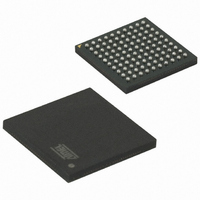ATSAM3U4CA-CU Atmel, ATSAM3U4CA-CU Datasheet - Page 341

ATSAM3U4CA-CU
Manufacturer Part Number
ATSAM3U4CA-CU
Description
IC MCU 32BIT 256KB FLSH 100TFBGA
Manufacturer
Atmel
Series
SAM3Ur
Specifications of ATSAM3U4CA-CU
Core Processor
ARM® Cortex-M3™
Core Size
32-Bit
Speed
96MHz
Connectivity
EBI/EMI, I²C, MMC, SPI, SSC, UART/USART, USB
Peripherals
Brown-out Detect/Reset, DMA, I²S, POR, PWM, WDT
Number Of I /o
57
Program Memory Size
256KB (256K x 8)
Program Memory Type
FLASH
Ram Size
52K x 8
Voltage - Supply (vcc/vdd)
1.65 V ~ 1.95 V
Data Converters
A/D 4x10b, 4x12b
Oscillator Type
Internal
Operating Temperature
-40°C ~ 85°C
Package / Case
100-TFBGA
Processor Series
ATSAM3x
Core
ARM Cortex M3
Data Bus Width
32 bit
Data Ram Size
52 KB
Interface Type
3xUSART, TWI, 4xSPI, Bus
Maximum Clock Frequency
96 MHz
Number Of Programmable I/os
57
Number Of Timers
8
Operating Supply Voltage
1.62 V to 3.6 V
Maximum Operating Temperature
+ 85 C
Mounting Style
SMD/SMT
3rd Party Development Tools
JTRACE-CM3, MDK-ARM, RL-ARM, ULINK2
Development Tools By Supplier
ATSAM3U-EK
Minimum Operating Temperature
- 40 C
Lead Free Status / RoHS Status
Lead free / RoHS Compliant
Eeprom Size
-
Lead Free Status / Rohs Status
Lead free / RoHS Compliant
Available stocks
Company
Part Number
Manufacturer
Quantity
Price
Part Number:
ATSAM3U4CA-CU
Manufacturer:
ATMEL/爱特梅尔
Quantity:
20 000
- Current page: 341 of 1171
- Download datasheet (25Mb)
24.4.1.2
24.4.2
24.4.2.1
24.4.2.2
24.4.2.3
6430D–ATARM–25-Mar-11
Round-Robin Arbitration
Slot Cycle Limit Arbitration
Round-Robin arbitration without default master
Round-Robin arbitration with last access master
Round-Robin arbitration with fixed default master
3. Eight beat bursts: predicted end of burst is generated at the end of each eight beat boundary
inside INCR transfer.
4. Sixteen beat bursts: predicted end of burst is generated at the end of each sixteen beat
boundary inside INCR transfer.
This selection can be done through the field ULBT of the Master Configuration Registers
(MATRIX_MCFG).
The Bus Matrix contains specific logic to break too long accesses such as very long bursts on a
very slow slave (e.g. an external low speed memory). At the beginning of the burst access, a
counter is loaded with the value previously written in the SLOT_CYCLE field of the related Slave
Configuration Register (MATRIX_SCFG) and decreased at each clock cycle. When the counter
reaches zero, the arbiter has the ability to re-arbitrate at the end of the current byte, half word or
word transfer.
This algorithm allows the Bus Matrix arbiters to dispatch the requests from different masters to
the same slave in a round-robin manner. If two or more master’s requests arise at the same
time, the master with the lowest number is first serviced then the others are serviced in a round-
robin manner.
There are three round-robin algorithm implemented:
This is the main algorithm used by Bus Matrix arbiters. It allows the Bus Matrix to dispatch
requests from different masters to the same slave in a pure round-robin manner. At the end of
the current access, if no other request is pending, the slave is disconnected from all masters.
This configuration incurs one latency cycle for the first access of a burst. Arbitration without
default master can be used for masters that perform significant bursts.
This is a biased round-robin algorithm used by Bus Matrix arbiters. It allows the Bus Matrix to
remove the one latency cycle for the last master that accessed the slave. In fact, at the end of
the current transfer, if no other master request is pending, the slave remains connected to the
last master that performs the access. Other non privileged masters will still get one latency cycle
if they want to access the same slave. This technique can be used for masters that mainly per-
form single accesses.
This is another biased round-robin algorithm, it allows the Bus Matrix arbiters to remove the one
latency cycle for the fixed default master per slave. At the end of the current access, the slave
remains connected to its fixed default master. Every request attempted by this fixed default mas-
ter will not cause any latency whereas other non privileged masters will still get one latency
cycle. This technique can be used for masters that mainly perform single accesses.
• Round-Robin arbitration without default master
• Round-Robin arbitration with last access master
• Round-Robin arbitration with fixed default master
SAM3U Series
341
Related parts for ATSAM3U4CA-CU
Image
Part Number
Description
Manufacturer
Datasheet
Request
R

Part Number:
Description:
KIT EVAL FOR AT91SAM3U CORTEX
Manufacturer:
Atmel
Datasheet:

Part Number:
Description:
AT91 ARM Thumb-based Microcontrollers
Manufacturer:
ATMEL [ATMEL Corporation]
Datasheet:

Part Number:
Description:
DEV KIT FOR AVR/AVR32
Manufacturer:
Atmel
Datasheet:

Part Number:
Description:
INTERVAL AND WIPE/WASH WIPER CONTROL IC WITH DELAY
Manufacturer:
ATMEL Corporation
Datasheet:

Part Number:
Description:
Low-Voltage Voice-Switched IC for Hands-Free Operation
Manufacturer:
ATMEL Corporation
Datasheet:

Part Number:
Description:
MONOLITHIC INTEGRATED FEATUREPHONE CIRCUIT
Manufacturer:
ATMEL Corporation
Datasheet:

Part Number:
Description:
AM-FM Receiver IC U4255BM-M
Manufacturer:
ATMEL Corporation
Datasheet:

Part Number:
Description:
Monolithic Integrated Feature Phone Circuit
Manufacturer:
ATMEL Corporation
Datasheet:

Part Number:
Description:
Multistandard Video-IF and Quasi Parallel Sound Processing
Manufacturer:
ATMEL Corporation
Datasheet:

Part Number:
Description:
High-performance EE PLD
Manufacturer:
ATMEL Corporation
Datasheet:

Part Number:
Description:
8-bit Flash Microcontroller
Manufacturer:
ATMEL Corporation
Datasheet:

Part Number:
Description:
2-Wire Serial EEPROM
Manufacturer:
ATMEL Corporation
Datasheet:











